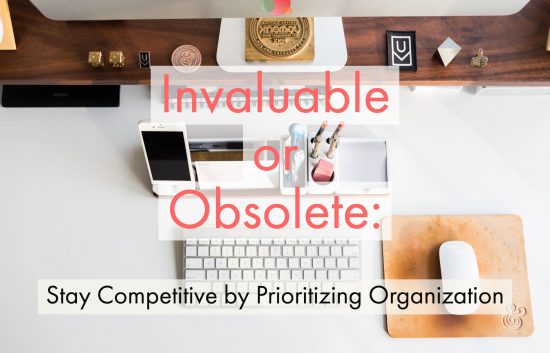 There are few things more visually satisfying than a well-organized bookcase or even a kitchen with spices, food, and utensils thoughtfully arranged.
There are few things more visually satisfying than a well-organized bookcase or even a kitchen with spices, food, and utensils thoughtfully arranged.
It’s easy to hop on Pinterest and find inspiration for your home organization needs, but what about when it comes to your marketing agency?
Don’t take this lightly.
By prioritizing organization, you can dictate whether an agency is invaluable or obsolete.
According to Agency New Business Insights, 80 percent of agencies foresee their clients moving some marketing services in-house—a 23 percent increase over last year’s prediction.
In-house teams typically don’t face the same challenges as agencies, but when they do encounter obstacles, they are allowed more slack.
And the advantage of having in-house employees, is they are more familiar with the company mission, values, products, and audience than any agency could be.
In-house teams also cost less and respond faster.
Prioritizing Organization: Prove Your Worth
To stay competitive, agencies must provide services that are worth the extra time and dime.
As small businesses bring marketing in-house, the most successful agencies will be those demonstrating clear value to clients.
This is where prioritizing organization comes in.
Without it, agencies will struggle to respond quickly to client and prospect demands, leaving the door open for more organized in-house competitors.
Prioritizing Organization: The Path to Success
When managing multiple clients, agencies must stay on top of their organization processes to ensure project details don’t fall through the cracks.
Brands hire agencies to hit aggressive deadlines which their internal teams can’t successfully meet.
In turn, agencies are challenged to deliver on the promise of speed, as well as hitting or beating deadlines, to keep frequent clients satisfied.
With this in mind, nothing facilitates speed like prioritizing organization.
Just as a mechanic can fix a car faster when his tools are in the right place, agencies can deliver on client expectations ahead of schedule when they have defined processes.
Demonstrating these processes to clients—and their ROI—is the key to persuading new prospects and bringing back old customers.
Follow these three strategies for prioritizing organization and you will “wow” clients with speed and quality:
Create Timelines for Every Project
Agencies must commit to hitting every deadline—no matter what.
But remember, no two deadlines are the same.
Some require weeks of work with multiple phases and iterations.
An agency that sets only the final deadline—without accounting for every stage along the way is setting itself up for failure.
Before beginning a new project, work with the entire team to set multiple deadlines along a larger timeline.
Team members should know how long their parts of the project will take to complete.
Feedback can also help leaders identify pain points, anticipate delays, and take predictive countermeasures.
Collaborating on a timeline creates a well-organized workflow and makes team members feel empowered, ensuring continued peak-level performance.
Remember to involve the client in this process as well.
This ensures the client feels connected and provides an opportunity to add in any missing requirements.
Establish Clear Workflows
When projects stall between task owners, valuable time is wasted.
Here’s a good rule of thumb: Any gap in time is too long. Instead, eliminate this issue by prioritizing organization of workflow.
Create workflows that feature concrete procedures for delegation and accountability.
Ensure each team member knows that part of each task includes passing the project to the next person.
Build and distribute organizational charts describing roles of each team member and owned tasks.
For each piece of collateral, define expectations for what a completed step looks like.
At what stage should copy move to graphic design?
Who signs off on each step?
Who is responsible for providing a second set of eyes?
Whether through project management software or a simple checklist, every project should be traceable from start to finish before work begins.
You can prevent team frustration by ensuring each member understands (and agrees with) his or her role.
Too often, one member becomes irritated while covering a task that should belong to someone else, while the responsible party remains unaware.
Most importantly, take extra care when it comes to the steps right before clients see the work.
Even rough drafts should appear professional, with no trace of typos or obvious errors.
Communicate Each Milestone
If an agency is doing incredible work behind the scenes, but the client only sees the finished product, that client might not understand or appreciate the full value of the services provided—decreasing the agency’s odds of securing a second job.
Counteract this by displaying organizational prowess early and often.
The easiest way to do this is by simply communicating frequently with clients.
Avoid ambiguity by setting a recurring meeting to go over progress, answer questions, and collaborate with the client’s team.
The more transparent the game plan is from beginning to end, the more likely you will have an informed and at-ease client.
When the inevitable delays happen—as they always do—don’t try to hide them.
Be honest instead.
Communicate the delay, outline why it occurred, and walk the client through the steps to work through it and remain on schedule.
Even if the delay is on the agency’s side, clients will be impressed by your ability to bounce back from adversity and deliver high-quality services on time.
Running a tight ship is not just for nautical deckhands.
Prioritizing organization makes it much easier for marketing agencies to weather the competitive high winds of rising in-house agencies.
So take strong hold of your agency’s wheel, and steer it toward a more organized horizon.
Those uncharted waters won’t be so intimidating once you know you have everything in the right place to succeed.
Is prioritizing organization a key to your agency’s success?
Please share your thoughts in the comments below.